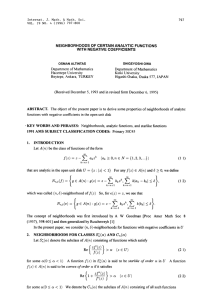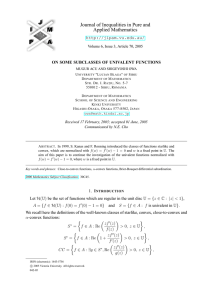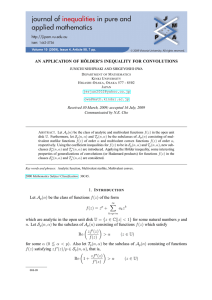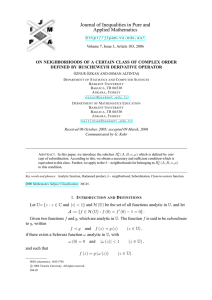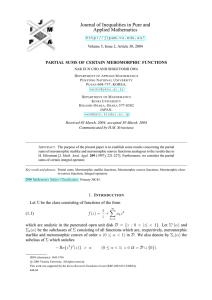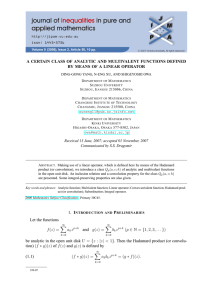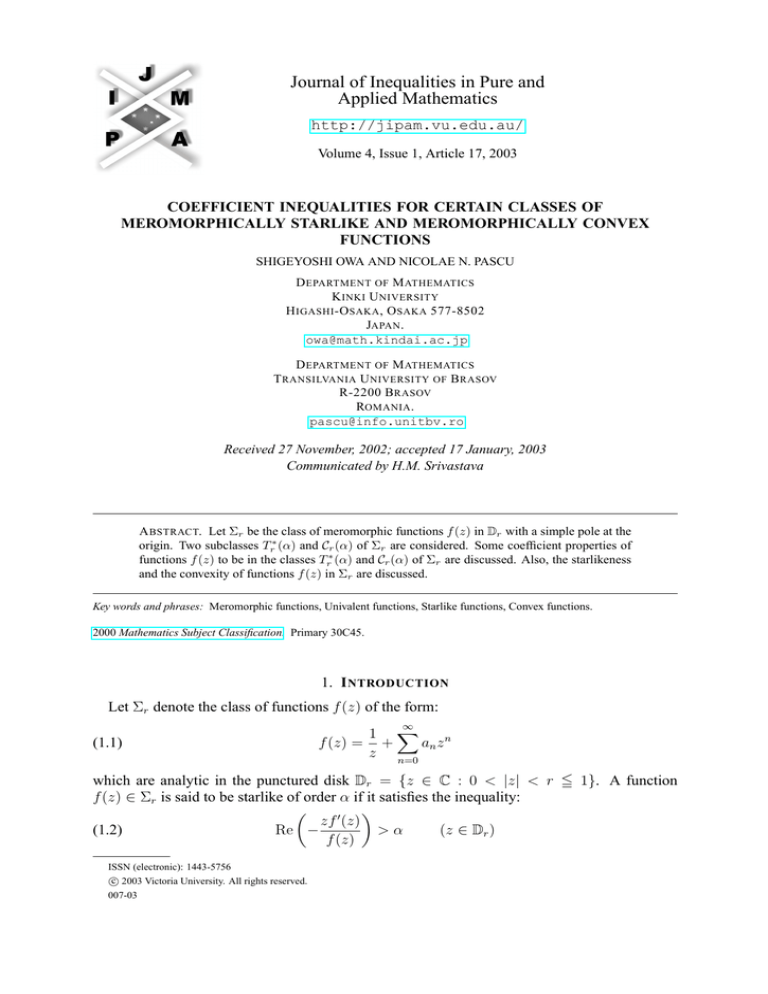
Journal of Inequalities in Pure and
Applied Mathematics
http://jipam.vu.edu.au/
Volume 4, Issue 1, Article 17, 2003
COEFFICIENT INEQUALITIES FOR CERTAIN CLASSES OF
MEROMORPHICALLY STARLIKE AND MEROMORPHICALLY CONVEX
FUNCTIONS
SHIGEYOSHI OWA AND NICOLAE N. PASCU
D EPARTMENT OF M ATHEMATICS
K INKI U NIVERSITY
H IGASHI -O SAKA , O SAKA 577-8502
JAPAN .
owa@math.kindai.ac.jp
D EPARTMENT OF M ATHEMATICS
T RANSILVANIA U NIVERSITY OF B RASOV
R-2200 B RASOV
ROMANIA .
pascu@info.unitbv.ro
Received 27 November, 2002; accepted 17 January, 2003
Communicated by H.M. Srivastava
A BSTRACT. Let Σr be the class of meromorphic functions f (z) in Dr with a simple pole at the
origin. Two subclasses Tr∗ (α) and Cr (α) of Σr are considered. Some coefficient properties of
functions f (z) to be in the classes Tr∗ (α) and Cr (α) of Σr are discussed. Also, the starlikeness
and the convexity of functions f (z) in Σr are discussed.
Key words and phrases: Meromorphic functions, Univalent functions, Starlike functions, Convex functions.
2000 Mathematics Subject Classification. Primary 30C45.
1. I NTRODUCTION
Let Σr denote the class of functions f (z) of the form:
∞
(1.1)
1 X
f (z) = +
an z n
z n=0
which are analytic in the punctured disk Dr = {z ∈ C : 0 < |z| < r 5 1}. A function
f (z) ∈ Σr is said to be starlike of order α if it satisfies the inequality:
zf 0 (z)
(1.2)
Re −
>α
(z ∈ Dr )
f (z)
ISSN (electronic): 1443-5756
c 2003 Victoria University. All rights reserved.
007-03
2
S HIGEYOSHI OWA AND N ICOLAE N. PASCU
for some α (0 5 α < 1). We say that f (z) is in the class Tr∗ (α) for such functions. A function
f (z) ∈ Σr is said to be convex of order α if it satisfies the inequality:
zf 00 (z)
(1.3)
Re − 1 + 0
>α
(z ∈ Dr )
f (z)
for some α (0 5 α < 1). We say that f (z) is in the class Cr (α) if it is convex of order α
in Dr . We note that f (z) ∈ Cr (α) if and only if −zf 0 (z) ∈ Tr∗ (α). There are many papers
discussing various properties of classes consisting of univalent, starlike, convex, multivalent,
and meromorphic functions in the book by Srivastava and Owa [3].
Ozaki [2] has shown that the necessary and sufficient condition that f (z) ∈ Σr with an =
0 (n = 1, 2, 3, · · · ) is meromorphic and univalent in Dr is that there should exist the relation:
∞
X
nan rn+1 5 1
n=1
between its coefficients.
Our results in the present paper are an improvement and extension of the above theorem by
Ozaki [2].
2. C OEFFICIENT I NEQUALITIES FOR F UNCTIONS
Our first result for the functions f (z) ∈ Σr is contained in
Theorem 2.1. If f (z) ∈ Σr satisfies
∞
X
(2.1)
(n + k + |2α + n − k|)|an |rn+1 5 2(1 − α)
n=0
for some α (0 5 α < 1) and k (α < k 5 1), then f (z) ∈ Tr∗ (α).
Proof. For f (z) ∈ Σr , we know that
|zf 0 (z) + kf (z)| − |zf 0 (z) + (2α − k)f (z)|
∞
∞
X
1 X
1
= (k − 1) +
(n + k)an z n − (2α − k − 1) +
(2α + n − k)an z n .
z
z
n=0
n=0
Therefore, applying the condition of the theorem, we have
r |zf 0 (z) + kf (z)| − r |zf 0 (z) + (2α − k)f (z)|
∞
∞
X
X
n+1
5 (k − 1) +
(n + k)|an |r
− (k + 1 − 2α) +
|2α + n − k||an |rn+1
n=0
∞
X
= 2(α − 1) +
n=0
(n + k + |2α + n − k|)|an |rn+1
n=0
5 0,
which shows that
∞
X
(n + k + |2α + n − k|)|an |rn+1 5 2(1 − α).
n=0
It follows from the above that
zf 0 (z) + kf (z)
zf 0 (z) + (2α − k)f (z) 5 1,
J. Inequal. Pure and Appl. Math., 4(1) Art. 17, 2003
http://jipam.vu.edu.au/
C OEFFICIENT I NEQUALITIES FOR C ERTAIN C LASSES OF M EROMORPHICALLY S TARLIKE AND M EROMORPHICALLY C ONVEX F UNCTIONS 3
so that
zf 0 (z)
Re −
f (z)
>α
(z ∈ Dr ).
Letting k = 0 in Theorem 2.1, we have
Corollary 2.2. If f (z) ∈ Σr satisfies
∞
X
(2.2)
(n + α)|an |rn+1 5 1 − α
n=0
for some α
5 α < 1), then f (z) ∈ Tr∗ (α).
Theorem 2.1 gives us the following results.
n+1
Corollary 2.3. Let the function f (z) ∈ Σr be given by (1.1) with an = |an |e− 2π i , then f (z) ∈
Tr∗ (α) if and only if
∞
X
(2.3)
(n + α)|an |rn+1 5 1 − α
( 21
n=0
for some
α ( 21
5 α < 1).
Proof. In view of Theorem 2.1, we see that if the coefficient inequality (2.3) holds true for some
α ( 12 5 α < 1), then f (z) ∈ Tr∗ (α).
Conversely, let f (z) be in the class Tr∗ (α), then
P
1− ∞
nan z n+1
zf 0 (z)
n=0
P
Re −
= Re
>α
n+1
f (z)
1+ ∞
n=0 an z
1
for all z ∈ Dr . Letting z = re 2π i , we have that an z n+1 = |an |rn+1 . This implies that
!
∞
∞
X
X
1−
n|an |rn+1 = α 1 +
|an |rn+1 ,
n=0
n=0
which is equivalent to (2.3).
Example 2.1. The function f (z) given by
1
f (z) = + a0 +
z
1 − α − α|a0 |
n+α
belongs to the class Tr∗ (α) for some real θ with
1
2
5α5
1
1+|a0 |
eiθ z n
< 1.
Remark 2.4. If f (z) ∈ Σr with a0 = 0, then Corollary 2.3 holds true for some α (0 5 α < 1).
Corollary 2.5. Let the function f (z) ∈ Σr be given by (1.1) with an = 0, then f (z) ∈ Tr∗ (α) if
and only if
∞
X
(n + α)an rn+1 5 1 − α
n=0
α ( 12
for some
5 α < 1).
Remark 2.6. If f (z) ∈ Σr with a0 = 0, then Corollary 2.5 holds true for 0 5 α < 1.
Remark 2.7. Juneja and Reddy [1] have given that f (z) ∈ Σ1 with a0 = 0 and an = 0 belongs
to the class T1∗ (α) if and only if
∞
X
(n + α)an 5 1 − α.
n=1
J. Inequal. Pure and Appl. Math., 4(1) Art. 17, 2003
http://jipam.vu.edu.au/
4
S HIGEYOSHI OWA AND N ICOLAE N. PASCU
Theorem 2.8. If f (z) ∈ Σr satisfies
∞
X
(2.4)
n(n + α)|an |rn+1 5 1 − α
n=1
for some α (0 5 α < 1), then f (z) belongs to the class Cr (α).
Proof. Noting that f (z) ∈ Cr (α) if and only if −zf 0 (z) ∈ Tr∗ (α), and that
∞
1 X
nan z n ,
−zf (z) = −
z n=1
0
we complete the proof of the theorem with the aid of Theorem 2.1.
Corollary 2.9. Let the function f (z) ∈ Σr be given by (1.1) with an = |an |e−
Cr (α) if and only if the inequality (2.4) holds true for some α (0 5 α < 1).
n+1
i
2π
, then f (z) ∈
Example 2.2. The function f (z) given by
1
f (z) = + a0 +
z
1−α
n(n + α)
eiθ z n
belongs to the class Cr (α) for some real θ with 0 5 α < 1.
Corollary 2.10. Let the function f (z) ∈ Σr be given by (1.1) with an = 0, then f (z) ∈ Cr (α)
if and only if
∞
X
(2.5)
n(n + α)an rn+1 5 1 − α
n=1
for some α (0 5 α < 1).
3. S TARLIKENESS AND C ONVEXITY OF F UNCTIONS
We consider the radius problems for starlikeness and convexity of functions f (z) belonging
to the class Σr .
Theorem 3.1. A function f (z) ∈ Σr belongs to the class Tr∗ (α) for 0 5 r < r0 , where r0 is the
smallest positive root of the equation
(3.1)
α|a0 |r3 − (δ + 1 − α)r2 − α|a0 |r + 1 − α = 0,
and
(3.2)
v
v
u∞
u∞
X
u
uX 1
2
t
n|an | + αt
|an |2 .
δ=
n
n=1
n=1
J. Inequal. Pure and Appl. Math., 4(1) Art. 17, 2003
http://jipam.vu.edu.au/
C OEFFICIENT I NEQUALITIES FOR C ERTAIN C LASSES OF M EROMORPHICALLY S TARLIKE AND M EROMORPHICALLY C ONVEX F UNCTIONS 5
Proof. Using the Cauchy inequality, we see that
∞
X
(n + α)|an |rn+1
n=0
= α|a0 |r +
∞
X
|an |rn+1
n=1
v
v
v
v
u∞
u∞
u∞
u∞
uX
uX
uX
uX 1
|an |2 t
5 α|a0 |r + t
n|an |2 t
nr2n+2 + αt
nr2n+2
n
n=1
n=1
n=1
n=1
v
v
s
u∞
u∞
uX
uX 1
r4
2 + αt
t
= α|a0 |r +
|an |2
n|a
|
n
(1 − r2 )2
n
n=1
n=1
= α|a0 |r +
r2
δ < 1 − α,
1 − r2
where δ is given by (3.2). Therefore, an application of Corollary 2.2 gives us that f (z) ∈ Tr∗ (α)
for 0 5 r < r0 .
Letting a0 = 0 in Theorem 3.1, we have
Corollary 3.2. A function f (z) ∈ Σr with a0 = 0 belongs to the class Tr∗ (α) for 0 5 r < r0 ,
where
r
δ
r0 = 1 −
δ+1−α
and δ is given by (3.2).
Example 3.1. If we consider the function f (z) given by
∞
1 X 1 iθn n
√ e z
f (z) = +
z n=1 n n
(θn is real),
then f (z) ∈ Tr∗ (α) for 0 5 r < r0 with
v
v
u∞
u∞
uX 1
uX 1
t
+
α
δ=t
2
n
n4
n=1
n=1
p
p
= ζ(2) + α ζ(4)
πα
1
=π √ + √
.
6 3 10
Further, letting α = 0, we have that
π
δ = √ u 1.282550
6
and
s √
6
u 0.661896.
r0 = √
6+π
Finally, for convexity of functions f (z), we derive
J. Inequal. Pure and Appl. Math., 4(1) Art. 17, 2003
http://jipam.vu.edu.au/
6
S HIGEYOSHI OWA AND N ICOLAE N. PASCU
Theorem 3.3. A function f (z) ∈ Σr belongs to the class Cr (α) for 0 5 r < r1 , where
r
σ
r1 = 1 −
σ+1−α
and
v
v
u∞
u∞
uX
uX
σ=t
n3 |an |2 + αt
n|an |2 .
n=1
n=1
Example 3.2. Let us consider the function f (z) given by
∞
1 X 1
√ eiθn z n
(θn is real).
f (z) = +
2
z n=1 n n
We see that f (z) ∈ Cr (α) for 0 5 r < r0 with
1
πα
δ=π √ + √
.
6 3 10
Taking α = 0, we obtain
π
δ = √ u 1.282550
6
and
s √
6
r0 = √
u 0.661896.
6+π
R EFERENCES
[1] O.P. JUNEJA AND T.R. REDDY, Meromorphic starlike and univalent functions with positive coefficients, Ann. Univ. Mariae Curie-Sklodowska, 39(1985), 65–76.
[2] S. OZAKI, Some remarks on the univalency and multivalency of functions, Sci. Rep. Tokyo Bunrika
Daigaku, 2(1934), 41–55.
[3] H.M. SRIVASTAVA AND S. OWA (Ed.), Current Topics in Analytic Function Theory, World Scientific Publishing Company, Singapore, New Jersey, London, and Hong Kong, 1992.
J. Inequal. Pure and Appl. Math., 4(1) Art. 17, 2003
http://jipam.vu.edu.au/







